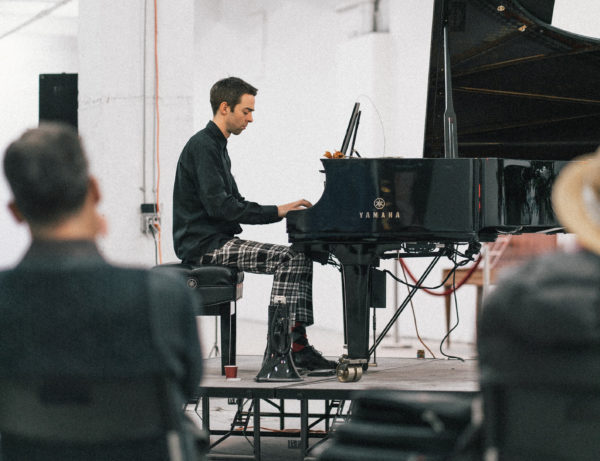
独学でピアノを学ぶ大人の初心者のための学習講座です。
初回は「ピアノの正しい弾き方」を覚えていきましょう。
これを無意識にできるようになると、自然とピアノが演奏しやすくなり、ピアノの上達スピードが上がります。
初回から理屈っぽい話になりますが、文章で覚える必要はなく、最初に体で覚えることが重要です。
楽しいレッスンではありませんが、しっかりと学習しましょう。
では詳しく解説していきます。
所要時間は「約15分」です。
目次
今回のテーマ
- 「座り方」
- 「手の置き方」
- 「椅子の位置」
- 「椅子の高さ」
座り方

まず初めに覚えることはピアノの椅子の座り方です。
間違った座り方でピアノを練習しても上手くなりません。
とくに目標としている曲の難易度が高ければ高いほどピアノの座り方は重要になってきます。
①浅く座る
ピアノの鍵盤は指の力だけで押すものではありません。
上半身の体重をかけて演奏します。
それを行うためにも、椅子に浅く座るようにしましょう。
目安としては、座ったままひざを動かして股を開けたり閉めたりすることが自由にできる程度です。
ほとんど太ももが椅子にのらないぐらいになりますよね。
逆にピアノの椅子に深く座ってしまうと、鍵盤にかけるはずの体重が椅子にかかってしまい、鍵盤を押すことに苦労してしまいます。
そうなるとひとつの鍵盤を押して、次の鍵盤を押すまでの動作が遅くなってしまうのです。
これは難しい曲・テンポの速い曲を演奏する際に特に実感できます。
浅く座る位置をしっかり覚えておきましょう。
②背筋を伸ばす
次に考えるのは姿勢です。
よくピアノを演奏する際に、背中を丸めたまま演奏する方がいらっしゃいますが、これは正しくありません。
基本的に背筋を伸ばして演奏することが正しい姿勢です。
ピアノが上手な人が、背中を丸めて演奏しているシーンを見たことがあるかもしれませんが、あれは演奏に抑揚をつけるために体重移動を工夫するテクニックです。
あれが基本的な演奏方法ではありませんのでご注意ください。
とはいえ背筋をピンと張るほど伸ばす必要はありません。
あまり力が入りすぎると、鍵盤に体重をかけられなくなってしまいます。
次に紹介しますが、きれいに90°にする必要はありませんのでご注意ください。
背中を真っ直ぐすることに意識しながらも、適度にリラックスしてください。

③少しだけ前かがみになる
次に体の重心の位置です。
前述の通り、ピアノの鍵盤は体重をかけて押すものです。
上半身がきれいに90°になっていたり、逆に反りすぎていれば鍵盤を押す際に指の力だけで押すことになってしまいます。
そうならないように、少しだけ前傾姿勢になり、スムーズに体重を鍵盤にのせられるようにしましょう。
④あごを引く
最後は顔です。
写真をとるときなどに力が入ってしまって、あごが上がったことはありませんか?
ピアノの演奏でも同じようなことが起こりがちです。
必ず顔の正面を「楽譜をのせるところと、鍵盤の間」ぐらいにして適度にあごを引くようにしましょう。
手の置き方

次に覚えるのは手の置き方です。
これは特に気をつけるべきポイントです。
というのも、ネットで見かける画像や動画には、間違った指の置き方をしている方が非常に多く感じます。
きちんと初心者のうちから手の置き方を意識してしっかり習得しましょう。
①肩の力を抜く
まず大前提なのが、肩の力を抜くことです。
「姿勢」と、後述する「椅子の高さ」を正しくしていれば自然にリラックスできる状態になります。
まずは姿勢を正した状態で鍵盤に手をのせずに、「だら〜ん」と手を真下に落としてみましょう。
この時の力の抜け具合をよく覚えておいてください。
この肩の状態でピアノを演奏することになります。
よくあるのが、前傾姿勢になりすぎたりして肩に力が入り、窮屈そうな格好での演奏です。
これだと肩を動かせなくなり、カタコトの言葉のように音と音の間に不自然な空きが生まれてしまいます。
特に鍵盤を多く使う曲になればなるほど、これは顕著に現れます。

②指先を鍵盤にのせる
次に実際に鍵盤に指をのせましょう。
指先にある指紋が丸まっているところ(指の腹)を鍵盤にのせてはいけません。
また手首は鍵盤にのせてはいけません。
「指先」だけを「垂直」に鍵盤にのせます。
(親指だけは斜めにのせる形になります)
これは指の皮膚の固さが理由です。
鍵盤を押す強さで音の大きさを調整するピアノでは、柔らかい指の腹を使うと、そのコントロールが難しくなるからです。
そのためピアノは比較的固い指先を使って演奏するのです。
もちろん爪は短く切っておきましょう。
演奏しにくいだけでなく、怪我の原因にもなってしまいます。
③手を丸める
最後に手の形です。
手は丸めて鍵盤におきましょう。
この「丸み」は教えるピアノの先生によって(もしくは国によって)様々な表現で教えられています。
私が小さい頃に教えられたときには「手のひらに卵を挟むような感じ」と教えられました。
手の大きさは人それぞれなので一概には言えませんが、例えていうなら「パソコンのキーボードを打つ時ぐらいの丸み」だと思います。
椅子の位置

次に椅子の位置です。
前後や左右の位置をしっかり意識することで、演奏した時の体の負担が変わってきます。
例えていうなら車の運転席の椅子の調整のようなものです。
面倒くさがらずに、毎回意識して椅子の位置を調整しましょう。
①鍵盤の中心に真っ直ぐ向ける
椅子を設置するときにはピアノの鍵盤の中心を向けるように位置を調整しましょう。
連弾(1台のピアノを2人で弾く)時や低音ばかり使う楽譜など特殊な時を除いて、ピアノの真ん中に体を向けられるように中央においてください。

②鍵盤よりも手前に置く
「椅子には浅く座る」ということは学習しました。
この浅く座った状態で、「鍵盤の下にひざがくる」位置が正しい椅子の位置です。
椅子をピアノの奥深くに入れすぎず、体にあった最適な位置を少しずつ調整しながら見つけていきましょう。
椅子の高さ

最後に椅子の高さです。
一人しか使わないなら最初に調整すれば終わりですが、何人かでピアノを使う場合はその都度椅子を調整した方がいいです。
スムーズにピアノを弾くためには高さが低すぎても高すぎてもいけません。
自分の体にあった高さに調整しましょう。

①かかとが床につく
最初に意識するのは足です。
椅子に座った状態でひざを90°にしてみましょう。
このとき、かかとがしっかり地面についていないと、鍵盤を押す力が不安定になります。
浅く座ったときに、かかとがしっかりつく高さに調整してください。
②鍵盤に指を置いたときに肘が90°になる
次に意識するのは肘です。
これまで説明した「姿勢」を意識して鍵盤に手を置いたときに、「肘がほぼ90°」になるような椅子の高さにしましょう。
椅子が高すぎると肘が開き、低すぎると肘が閉じてしまいます。
ピアノを演奏するときに、高い音や低い音を演奏することがあります。
そのとき右の鍵盤や左の鍵盤に腕をスライドするのですが、その動きの1つの支点となるのが肘です。
肘がその先の手をしっかり支えきれないと、「目の前の鍵盤はしっかり弾けるのに、右の鍵盤だと不安定になる」ということになってしまいます。
こうならないために椅子の高さを調整することで、最適な肘の角度を保つことが重要なのです。
このレッスンのまとめ
- 「座り方」
- ・太ももをほとんど乗せないぐらい浅く座る
- ・力まない程度に背筋を伸ばす
- ・顔がひじより前に出る程度にやや体を前に倒す
- ・あごを引き、鍵盤や譜面が見やすい位置に顔を向ける
- 「手の置き方」
- ・肩の力を抜く
- ・指先を鍵盤にのせる
- ・鍵盤と掌の間に卵を挟むイメージで手を丸める
- 「椅子の位置」
- ・ピアノの正面に真っ直ぐ向ける
- ・椅子に浅く座った時に鍵盤の下にひざがくる
- 「椅子の高さ」
- ・かかとが床につく
- ・鍵盤に指を置いたときに肘が90°になる
ぴょんぴょん says
ありがとうございます!やってみます!
きゅうり says
最近始めたので嬉しいです!